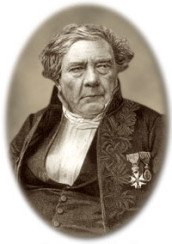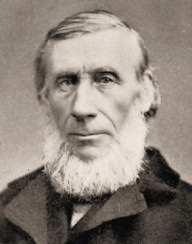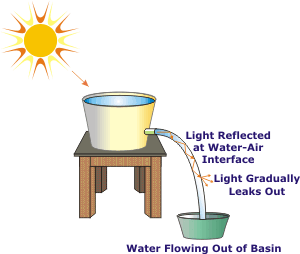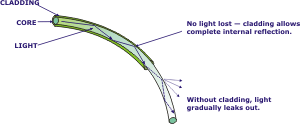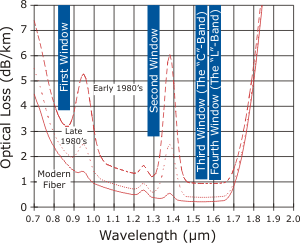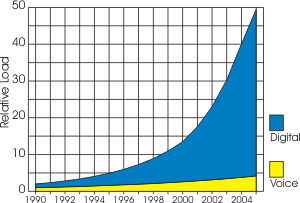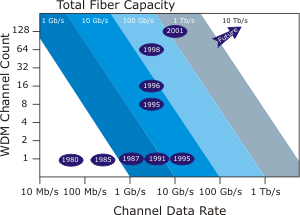| A Brief History of Optical Fiber | |||||
|
Source: David R. Goff. Fiber Optic Video Transmission, 1st ed. Focal Press: Woburn, Massachusetts, 2003 and other private writings. |
|||||
|
The Nineteenth Century The earliest attempts to communicate via light undoubtedly go back thousands of years. Early long distance communication techniques, such as "smoke signals", developed by native North Americans and the Chinese were, in fact, optical communication links. A larger scale version of this optical communication technique was the "optical telegraph" deployed in France and elsewhere in the late 18th century. The "optical telegraph" was a series of tall towers that passed along messages at a rate of a few words per minute by means of large semaphore flags that could be manipulated to spell out words. However, the development of fiber optic communication awaited the discovery of TIR (Total Internal Reflection) and a host of additional electronic and optical innovations. Jean-Daniel Colladon, a 38-year-old Swiss professor at
University of Geneva, demonstrated light guiding or TIR for the first
time in 1841. He wanted to show the fluid flow through various holes of
a tank and the breaking up of water jets. However, in the lecture hall
the audience could not see the flowing water. He solved the problem by
collecting and piping sunlight through a tube to the lecture table. The
light was focused through the water tank and was made to incident on the
edge of the jet at a glancing angle. TIR trapped the light in the liquid
forcing it to follow the curved path until the water jet broke up.
Instead of traveling in a straight line, the light followed the
curvature of the water flow. Colladon later on wrote: "I managed to
illuminate the interior of a stream in a dark space. I have discovered
that this strange arrangement offers in results one of the most
beautiful, and most curious experiments that one can perform in a course
on Optics." ( Comptes Rendes, 15, 800-802 Oct. 24, 1842). Colladon
demonstrated light guiding in water jets through a number of public
performances to the urban intelligentsia of Paris. Auguste de la Rive,
another Geneva Physicist, duplicated Colladon's experiment using
electric arc light. Colladon designed a spectacular device using arc
light for Conservatory of Arts and Science of Paris in 1841, Oct.. Colladon sent a paper to his friend Francois Arago who headed the French Academy of Sciences and edited its journal Comptes Renedes. Arago recalled that Jacques Babinet, a French specialist in Optics had made similar demonstrations in Paris. He focused candle light on to the bottom of a glass bottle as he poured a thin stream of water from the top. TIR guided the light along the jet. Arago asked Babinet to write down his work, but Babinet did not think that the work is very important. Yet he made a comment that "the idea also works very well with a glass shaft curved in what ever manner and I had indicated that (it could be used) to illuminate the inside of the mouth (Comptes Rendes 15, Oct. 24, 1842). After sending his letter to Arago, Babinet never returned to guiding of light before he died in 1872. In 1870, John Tyndall, using a jet of water that flowed from one container to another and a beam of light, demonstrated that light used internal reflection to follow a specific path. As water poured out through the spout of the first container, Tyndall directed a beam of sunlight at the path of the water. The light, as seen by the audience, followed a zigzag path inside the curved path of the water. This simple experiment, illustrated in Figure 4, marked the first research into the guided transmission of light. William Wheeling, in 1880, patented a method of light transfer called “piping light.” Wheeling believed that by using mirrored pipes branching off from a single source of illumination, i.e. a bright electric arc, he could send the light to many different rooms in the same way that water, through plumbing, is carried throughout buildings today. Due to the ineffectiveness of Wheeling’s idea and to the concurrent introduction of Edison’s highly successful incandescent light bulb, the concept of piping light never took off.
|
Figure 1 - Jean-Daniel Colladon
Figure 2 - Jacques Babinet
Figure 3 - John Tyndall
Figure 4 - Typical Early TIR (Total Internal Reflection) Demonstration
|
||||
| That same year, Alexander Graham Bell developed an optical voice transmission system he called the photophone. The photophone used free-space light to carry the human voice 200 meters. Specially placed mirrors reflected sunlight onto a diaphragm attached within the mouthpiece of the photophone. At the other end, mounted within a parabolic reflector, was a light-sensitive selenium resistor. This resistor was connected to a battery that was, in turn, wired to a telephone receiver. As one spoke into the photophone, the illuminated diaphragm vibrated, casting various intensities of light onto the selenium resistor. The changing intensity of light altered the current that passed through the telephone receiver which then converted the light back into speech. Bell believed this invention was superior to the telephone because it did not need wires to connect the transmitter and receiver. Today, free-space optical links find extensive use in metropolitan applications. | |||||
|
The Twentieth Century
Fiber optic technology experienced a phenomenal rate of progress in the second half of the twentieth century. Early success came during the 1950’s with the development of the fiberscope. This image-transmitting device, which used the first practical all-glass fiber, was concurrently devised by Brian O’Brien at the American Optical Company and Narinder Kapany (who first coined the term “fiber optics” in 1956) and colleagues at the Imperial College of Science and Technology in London. Early all-glass fibers experienced excessive optical loss, the loss of the light signal as it traveled through the fiber, limiting transmission distances. |
Figure 5 - Optical Fiber with Cladding |
||||
|
This motivated
scientists to develop glass fibers that included a separate glass
coating. The innermost region of the fiber, or
core, was used to transmit
the light, while the glass coating, or
cladding,
prevented the light from leaking out of the core by reflecting the light
within the boundaries of the core. This concept is explained by Snell’s
Law which states that the angle at which light is reflected is dependent
on the refractive indices of the two materials - in this case, the core
and the cladding. The lower
refractive index
of the cladding (with respect to the core) causes the light to be angled
back into the core as illustrated in
Figure 5.
The fiberscope quickly found application inspecting welds inside reactor vessels and combustion chambers of jet aircraft engines as well as in the medical field. Fiberscope technology has evolved over the years to make laparoscopic surgery one of the great medical advances of the twentieth century. The development of laser technology was the next important step in the establishment of the industry of fiber optics. Only the laser diode (LD) or its lower-power cousin, the light-emitting diode (LED), had the potential to generate large amounts of light in a spot tiny enough to be useful for fiber optics. In 1957, Gordon Gould popularized the idea of using lasers when, as a graduate student at Columbia University, he described the laser as an intense light source. Shortly after, Charles Townes and Arthur Schawlow at Bell Laboratories supported the laser in scientific circles. Lasers went through several generations including the development of the ruby laser and the helium-neon laser in 1960. Semiconductor lasers were first realized in 1962; these lasers are the type most widely used in fiber optics today. Because of their higher modulation frequency capability, the importance of lasers as a means of carrying information did not go unnoticed by communications engineers. Light has an information-carrying capacity 10,000 times that of the highest radio frequencies being used. However, the laser is unsuited for open-air transmission because it is adversely affected by environmental conditions such as rain, snow, hail, and smog. Faced with the challenge of finding a transmission medium other than air, Charles Kao and Charles Hockham, working at the Standard Telecommunication Laboratory in England in 1966, published a landmark paper proposing that optical fiber might be a suitable transmission medium if its attenuation could be kept under 20 decibels per kilometer (dB/km). At the time of this proposal, optical fibers exhibited losses of 1,000 dB/ km or more. Even at a loss of only 20 dB/km, 99% of the light would still be lost over only 3,300 feet. In other words, only 1/100th of the optical power that was transmitted reached the receiver. Intuitively, researchers postulated that the current, higher optical losses were the result of impurities in the glass and not the glass itself. An optical loss of 20 dB/km was within the capability of the electronics and optoelectronic components of the day. Intrigued by Kao and Hockham’s proposal, glass researchers began to work on the problem of purifying glass. In 1970, Drs. Robert Maurer, Donald Keck, and Peter Schultz of Corning succeeded in developing a glass fiber that exhibited attenuation at less than 20 dB/km, the threshold for making fiber optics a viable technology. It was the purest glass ever made. The early work on fiber optic light source and detector was slow and often had to borrow technology developed for other reasons. For example, the first fiber optic light sources were derived from visible indicator LED's. As demand grew, light sources were developed for fiber optics that offered higher switching speed, more appropriate wavelengths, and higher output power. For more information on light emitters see Laser Diodes and LED's. |
|||||
| Fiber optics developed over the years in a series of generations that can be closely tied to wavelength. Figure 6 shows three curves. The top, dashed, curve corresponds to early 1980’s fiber, the middle, dotted, curve corresponds to late 1980’s fiber, and the bottom, solid, curve corresponds to modern optical fiber. The earliest fiber optic systems were developed at an operating wavelength of about 850 nm. This wavelength corresponds to the so-called “first window” in a silica-based optical fiber. This window refers to a wavelength region that offers low optical loss. It sits between several large absorption peaks caused primarily by moisture in the fiber and Rayleigh scattering. |
Figure 6 - Four Wavelength Regions of Optical Fiber |
||||
|
The 850 nm region was initially attractive because the technology for light emitters at this wavelength had already been perfected in visible indicator and infrared (IR) LED's. Low-cost silicon detectors could also be used at the 850 nm wavelength. As the technology progressed, the first window became less attractive because of its relatively high 3 dB/km loss limit. Most companies jumped to the “second window” at 1310 nm with lower attenuation of about 0.5 dB/km. In late 1977, Nippon Telegraph and Telephone (NTT) developed the “third window” at 1550 nm. It offered the theoretical minimum optical loss for silica-based fibers, about 0.2 dB/km. Today, 850 nm, 1310 nm, and 1550 nm systems are all manufactured and deployed along with very low-end, short distance, systems using visible wavelengths near 660 nm. Each wavelength has its advantage. Longer wavelengths offer higher performance, but always come with higher cost. The shortest link lengths can be handled with wavelengths of 660 nm or 850 nm. The longest link lengths require 1550 nm wavelength systems. A “fourth window,” near 1625 nm, is being developed. While it is not lower loss than the 1550 nm window, the loss is comparable. |
|||||
|
Applications in the Real World
The U.S. military moved quickly to use fiber optics for improved communications and tactical systems. In the early 1970’s, the U.S. Navy installed a fiber optic telephone link aboard the U.S.S. Little Rock. The Air Force followed suit by developing its Airborne Light Optical Fiber Technology (ALOFT) program in 1976. Encouraged by the success of these applications, military R&D programs were funded to develop stronger fibers, tactical cables, ruggedized, high-performance components, and numerous demonstration systems ranging from aircraft to undersea applications. Commercial applications followed soon after. In 1977, both AT&T and GTE installed fiber optic telephone systems in Chicago and Boston respectively. These successful applications led to the increase of fiber optic telephone networks. By the early 1980’s, single-mode fiber operating in the 1310 nm and later the 1550 nm wavelength windows became the standard fiber installed for these networks. Initially, computers, information networks, and data communications were slower to embrace fiber, but today they too find use for a transmission system that has lighter weight cable, resists lightning strikes, and carries more information faster and over longer distances. The broadcast industry also embraced fiber optic transmission. In 1980, broadcasters of the Winter Olympics, in Lake Placid, New York, requested a fiber optic video transmission system for backup video feeds. The fiber optic feed, because of its quality and reliability, soon became the primary video feed, making the 1980 Winter Olympics the first fiber optic television transmission. Later, at the 1994 Winter Olympics in Lillehammer, Norway, fiber optics transmitted the first ever digital video signal, an application that continues to evolve today. In the mid-1980’s the United States government deregulated telephone service, allowing small telephone companies to compete with the giant, AT&T. Companies like MCI and Sprint quickly went to work installing regional fiber optic telecommunications networks throughout the world. Taking advantage of railroad lines, gas pipes, and other natural rights of way, these companies laid miles fiber optic cable, allowing the deployment of these networks to continue throughout the 1980’s. However, this created the need to expand fiber’s transmission capabilities. In 1990, Bell Labs transmitted a 2.5 Gb/s signal over 7,500 km without regeneration. The system used a soliton laser and an erbium-doped fiber amplifier (EDFA) that allowed the light wave to maintain its shape and density. In 1998, they went one better as researchers transmitted 100 simultaneous optical signals, each at a data rate of 10 gigabits (giga means billion) per second for a distance of nearly 250 miles (400 km). In this experiment, dense wavelength-division multiplexing (DWDM technology, which allows multiple wavelengths to be combined into one optical signal, increased the total data rate on one fiber to one terabit per second (1012 bits per second). |
|||||
|
The Twenty-first Century and Beyond
Today, DWDM technology continues to develop. As the demand for data bandwidth increases, driven by the phenomenal growth of the Internet, the move to optical networking is the focus of new technologies. At this writing, over 800 million people have Internet access and use it regularly. That's over 12% of the entire world's population of 6.4 billion people. The world wide web already hosts over 350 million domain names, 8 billion web pages (that's only the visible, indexed, Internet, the invisible Internet is estimated to be up to 100 times larger), and according to estimates people upload more than 3.5 million new web pages everyday. The Internet dominates traditional voice communication as shown in Figure 7. |
Figure 7 - Projected Internet Traffic Increases |
||||
|
The important factor in these developments is the increase in fiber transmission capacity, which has grown by a factor of 200 in the last decade. Figure 8 illustrates this trend.
Broadband service available to a mass market opens up a wide variety of interactive communications for both consumers and businesses, bringing to reality interactive video networks, interactive banking and shopping from the home, and interactive distance learning. The “last mile” for optical fiber goes from the curb to the television set top, known as fiber-to-the-home (FTTH) and fiber-to-the-curb (FTTC), allowing video on demand to become a reality. |
Figure 8 - The Growth of Optical Fiber Transmission Capacity |
||||
| Return to Top of Page | |||||
|
|||||


